Said Halim Pasha facts for kids
Quick facts for kids
Mehmed Said Halim
Pasha
|
|
|---|---|
 |
|
| Grand Vizier of the Ottoman Empire | |
| In office 12 June 1913 – 4 February 1917 |
|
| Monarch | Mehmed V |
| Preceded by | Mahmud Shevket Pasha |
| Succeeded by | Talaat Pasha |
| Personal details | |
| Born | 18 or 28 January 1865 or 19 February 1864 Cairo, Egypt Eyalet, Ottoman Empire |
| Died | 6 December 1921 (aged 56) Rome, Kingdom of Italy |
| Nationality | Ottoman |
| Relations | Muhammad Ali Pasha (grandfather) |
Mehmed Said Halim Pasha (Ottoman Turkish: سعيد حليم پاشا; Turkish: Sait Halim Paşa; 18 or 28 January 1865 or 19 February 1864 – 6 December 1921) was a was a statesman who served as the Grand Vizier of the Ottoman Empire from 1913 to 1917. He was one of the perpetrators of the Armenian genocide and later assassinated by Arshavir Shirakian as part of Operation Nemesis, a retribution campaign to kill perpetrators of the Armenian genocide.
Contents
Early life
Mehmed Said Halim was born at the palace of Shubra in Cairo, Egypt to Muhammad Abd al-Halim Pasha, one of the sons of Muhammed Ali Pasha, the founder of the Khedivet of Egypt. He was of Albanian origin. In 1870, he and his family settled in Istanbul. He was educated by private teachers, and learned Arabic, Persian, English, and French. He later studied political science in Switzerland.
In 1890 or 1895, he married Emine İnci Tosun, daughter of Mehmed Tosun Pasha. In the late 1890s the Prince Said Halim Pasha Palace in Downtown Cairo was built for him by the Italian architect Antonio Lasciac.
Political career
In 1888, Said Halim became a member of the Council of State with the rank of Mir-i Mîran, making him a civil Pasha. In 1900 he became the Rumeli Beylerbeyi. During this time he had good relations with Sultan Abdul Hamid II. Jealous courtiers spread rumors of Halim's disloyalty and propensity to read dangerous literature. Falling out of favor, he reduced his interest in his duty in the Council of State and retired to his mansion. In 1903, he was exiled from the capital for establishing relations with the Young Turks. He went first to Egypt and then to Europe and established direct relations with the Young Turks, giving them material and intellectual support. In 1906, he was appointed a leading role in the Committee of Progress and Union. Following the 1908 revolution, he returned to Istanbul.
While exiled, his position in the Council of State was never officially terminated, but he was finally dismissed by the council on September 3, 1908. He was appointed as the chief of the Yeniköy city council after its municipal election. He later became the Second Chief of the General Association of Municipalities (Cemiyet-i Umumiye-i Belediye İkinci Reisliği), and in 1908 he was appointed a member of the Ottoman Senate. He member of the administrative council of the Darüşşafaka. Between January 23, 1912 and July 23, 1912, he was chief of the Council of State in Said Pasha's cabinet. Halim was sent to Lausanne to negotiate a peace treaty to end the Italo-Turkish War on 3 July 1912, but the change in government spelled his fall from cabinet and he had to return home.
Following his resignation, he was elected as the General Secretary of the Committee of Union and Progress (CUP), and was appointed to the Council of State for the second time in 1913 during Mahmut Şevket Pasha's viziership, and to the Ministry of Foreign Affairs three days later. After the assassination of Şevket Pasha on 11 June 1913, he was first given the rank of vizier and was appointed to the Grand Vizier's Office, and the next day (12 June 1913) to the office of the Grand Vizier (Prime Minister). He was a compromise candidate for the CUP; Said Halim was more conservative and Islamist than the central committee would have wanted, however the prestige of his ancestry and his lack of agency made him an acceptable Grand Vizier to the CUP.
Grand Viziership
In September 1913, he was honored with the Order of Distinction by Sultan Mehmed Reşad for his service in signing the achieving a peace deal with the Bulgarians, and anchoring the border to the Maritsa river, beyond Edirne.
He was one of the signatures of Ottoman–German Alliance, which was signed in his mansion in Yeniköy with the German ambassador, Baron Wangenheim. Yet, he resigned after the incident of the pursuit of the Goeben and the Breslau, an event which served to bring the Ottoman Empire into the Great War. It is claimed that Sultan Reşad wanted a person in whom he trusted as Grand Vizier, and that he asked Said Halim to stay in his post as long as possible. When Britain annexed Egypt in 1914, Halim Pasha claimed the throne of the Egyptian monarchy based on a firman which changed Egyptian succession law half a century ago.
During the Armenian genocide, Said Halim signed the deportation orders for the Armenian population. The Armenian Patriarch Zaven I Der Yeghiayan appealed to him to cease the terror being committed against Armenians, which Said Halim replied to by claiming reports of arrests and deportations were being greatly exaggerated. Der Yeghiayan himself was later deported.
He lost his Foreign Ministry in 1915. Said Halim's premiership lasted until 1917, cut short because of continuous clashes between him and the CUP. The Interior Minister Mehmed Talaat Pasha succeeded him.
Arrest and assassination
Said Halim was accused of treason during the court martial trials after World War I in the Ottoman Empire for his role in deporting Armenian civilians and signing a secret alliance with Germany. He was exiled on 29 May 1919 to a prison on Malta. He was acquitted from the accusations and set free in 1921, and he moved to Sicily. He wanted to return to Istanbul, the capital of the Ottoman Empire, but this request was rejected. He was assassinated soon after in Rome by Arshavir Shirakian, an agent of the Armenian Revolutionary Federation, for his role in the Armenian genocide.
Works
- Buhranlarımız ve Son Eserleri – İz Yayıncılık
- Buhran-ı İçtimaimiz – Kubbealtı Sahaf
- Said Halim Paşa – Bütün Eserleri Anka Yayınları 2003
See also
- Said Halim government
- Operation Nemesis
- List of Ottoman grand viziers
- Muhammad Ali dynasty
Literature


